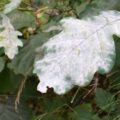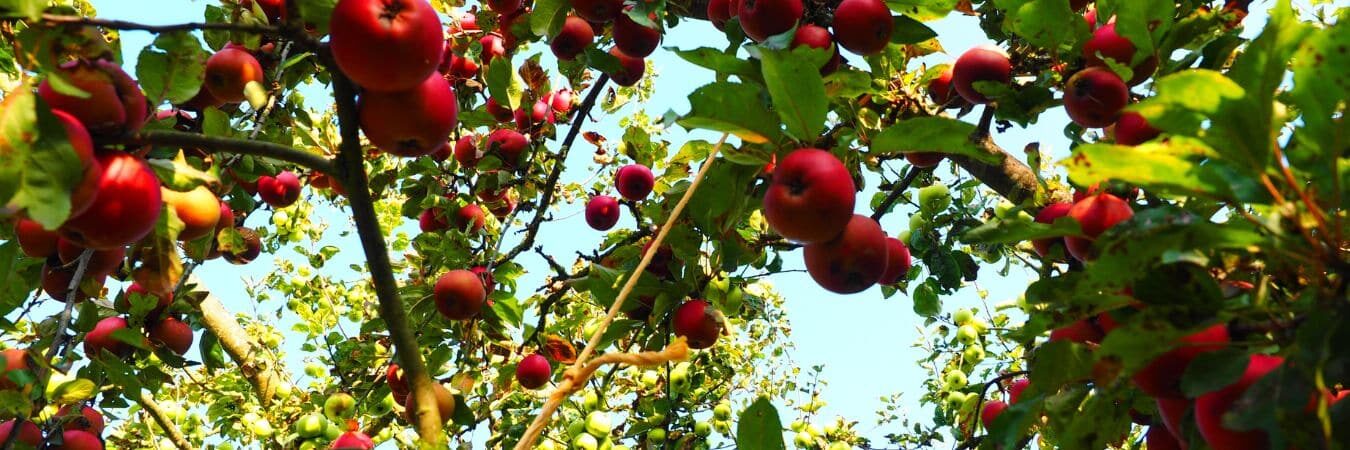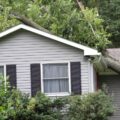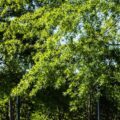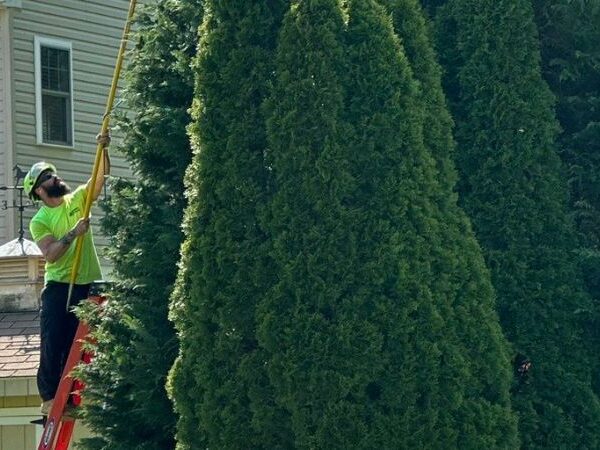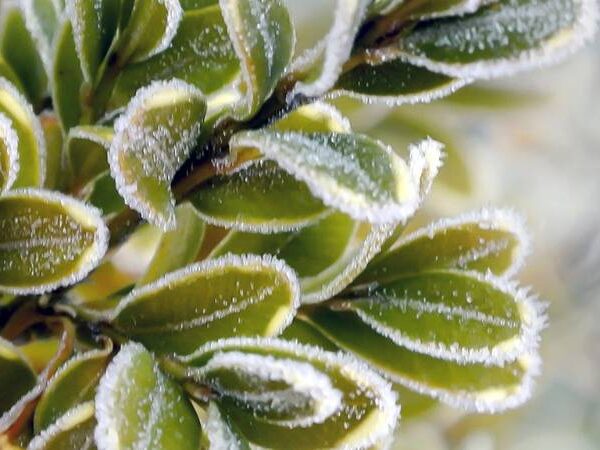Fire blight is a major concern for anyone in eastern Pennsylvania with apple or pear trees on their property. This bacterial disease is highly contagious and can kill trees if not treated in time. If you notice that your fruit trees look unhealthy and the leaves appear burnt, it may be a sign of fire blight infection. Take it as a wake-up call to seek professional treatment for your trees; early identification and preventive measures are critical to protecting fruit trees from this lethal disease.
Most of us who grow apple or pear trees do so to enjoy the spring blossoms and delicious fruit, both of which are destroyed by fire blight. In this article, you’ll learn to recognize the early signs of fire blight infection, how to prevent the disease from spreading to nearby trees, and what you can do if your tree is infected.
Key Takeaways
- Fire blight can spread to any plant in the Rosaceae family, such as apple or pear trees.
- Typical symptoms include leaves that turn dark and burned and black and cracked cankers on your trees.
- Prevention is always best; avoid creating open wounds during the spring and control insects that spread the disease.
- Pruning infected branches and limbs can limit the spread of the disease and protect trees from further damage.
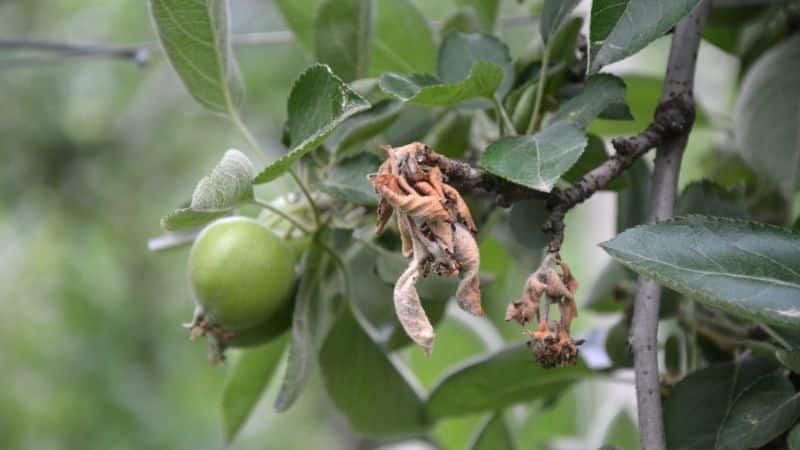
Fire Blight: What It Is & What It Does
Fire blight is a bacterial disease originating from the pathogen Erwinia amylovora. The disease targets plants in the Rosaceae family, most notably pears and apples. Other vulnerable plants in the family include crabapples, loquat, quinces, and hawthorn.
Fire blight kills blossoms and new shoots, as well as causing cankers on stems, leading to branch dieback. In severe cases, fire blight can kill a tree if left untreated.
The disease spreads through water contact and insects (such as bees, ants, flies, aphids, and beetles) that are attracted to the bacterial oozepollinators. that seeps from cankers on infected trees. Insects may carry the bacteria to nearby healthy trees where it enters through blossoms, fresh wounds, or natural cracks and openings in the tree. Rain, irrigation, wildlife, or gardeners may also spread the disease by splashing bacteria-laden water onto a healthy tree with an open wound.
Symptoms of Fire Blight to Watch Out For
Fire blight gets its name from the distinctive symptoms it causes.
- Infected leaves rapidly wilt and turn dark, looking like they suffered burns.
- Shoot blight causes new growth (shoots) to bend into a shape like a shepherd’s crook as it dies.
- Fruit on the tree turns dark and shrivels up, clinging to the branch for months.
- You may also notice cankers on your tree. These dead sections of bark on the tree trunk or branches often look black and cracked.
Environmental Factors That Affect the Spread of Fire Blight
To prevent, or at least slow down, the spread of fire blight, you need to know the conditions under which it spreads fastest.
Temperature: 75F to 82F
Fire blight causes the most damage when the weather is warm. The first symptoms typically appear in early spring when temperatures rise above 60F. As temperatures increase to between 75 and 82 degrees, fire blight will become more active and spread farther. If we have an early spring with unseasonably warm weather in eastern Pennsylvania, it could be a sign that fire blight will spread faster than normal.
Humidity: Above 60%
The bacterium that causes fire blight thrives at higher humidity levels, typically above 60 percent. Monitor the weather forecast and prepare for potential fire blight breakouts when humidity rises.
Rain
Rainfall helps to spread fire blight, and we often see very wet springs in Pennsylvania. Check the forecast and pay extra attention to any symptoms of fire blight when the spring weather is particularly wet.
How to Prevent the Spread of Fire Blight
Because there’s no cure for fire blight, prevention is paramount. Arborists have worked to develop fire blight prevention guidelines to help protect trees from this lethal disease. Following these prevention and control methods can protect you from a fire blight epidemic or help control an outbreak in progress on your property.
PRO TIP: Our team at Clauser Tree Care can assist with preventive measures and treatments to protect your trees from fire blight and a wide range of other tree diseases.
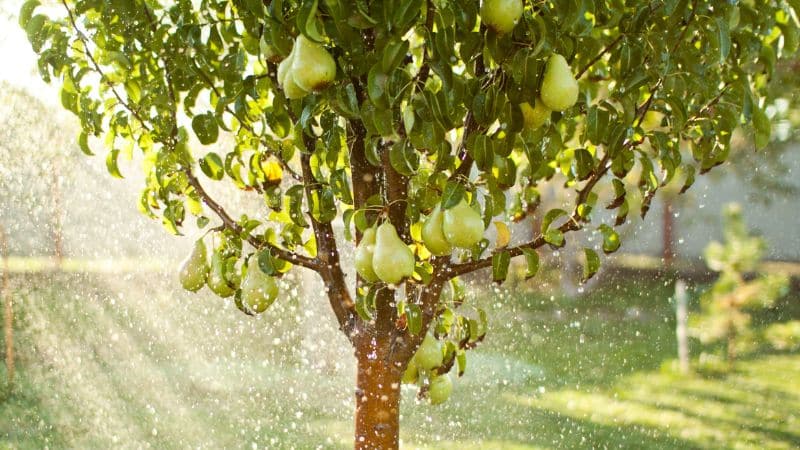
Water splashing on trees from rainfall or irrigation can spread fire blight to healthy trees. Avoid pruning trees during wet conditions to limit the chance of spreading the disease.
Avoid Pruning While It’s Wet
While this may not always be feasible, you should wait until the weather is dry before performing any pruning of your trees. The disease is carried through water droplets, so limiting a tree’s exposure to water while it has an open wound (such as from a pruning cut) can potentially protect it from an infection. We recommend pruning fruit trees during the winter when they are dormant.
Control Insects That May Spread the Disease
During the summer, after the initial infection period, you’ll want to do what you can to control any insects that might spread the disease further. These include insects like aphids or leafhoppers that may carry the bacteria to open wounds.
Limit Heavy Pruning and Nitrogen Fertilization
New growth is especially vulnerable to contracting fire blight. If you want to limit your tree’s risk of infection, you should avoid heavy pruning and nitrogen fertilization that will spur rapid growth.
While excessive pruning is unhealthy for your trees, you will want to maintain good pruning practices to keep an open canopy. Ensure your trees get enough air circulation throughout the canopy to help keep leaves dry; damp and humid environments encourage the growth of the bacteria that causes fire blight.
Burn Infected Material
If you notice fire blight developing on your trees, you’ll want to dispose of infected branches appropriately. After you or a tree care professional has pruned the infected branches, we recommend burning them in a location far away from your fruit tree(s), if possible. If you can’t, you can dry the branches and mulch them to kill the bacteria and limit further spread.
Treatment Options for Fire Blight
Fire blight cannot be cured. The only way to limit the spread and prevent further damage to trees is to prevent it from infecting your trees, or proactively taking steps to save infected trees.
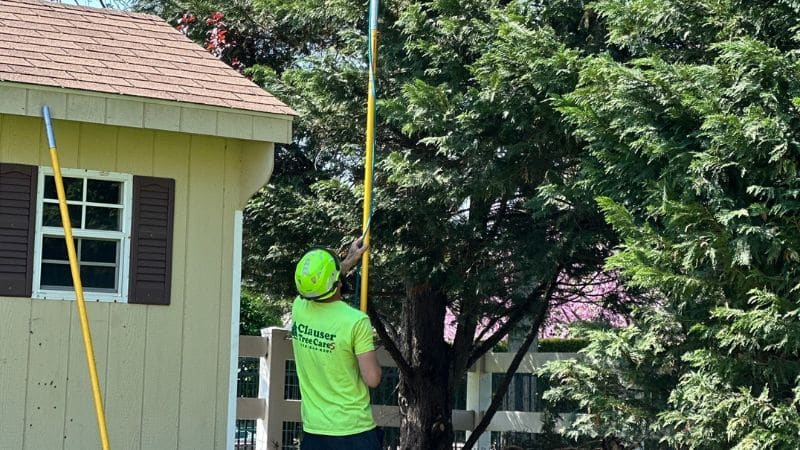
Prune Out Infected Branches & Cankers
Professional tree pruning during the dormant season is one of the best methods for controlling fire blight.
We recommend hiring arborists with experience dealing with diseases to do this properly as it’s not as simple as it may sound.
If you choose to take care of the problem yourself, you’ll need to prune off any infected twigs and branches, including any that show signs of cankers. These cankers are a major source of bacteria; they will cause blossom blight in spring and generate more cankers over the growing season, worsening the problem and spreading the disease to other trees. When making your pruning cuts, cut into healthy wood about eight to 12 inches below where you can see the canker or signs of infection. This berth should give you enough space to remove all parts of the branch that carry infection. Plus, older wood is more resistant to the disease.
When pruning an infected tree during the growing season clean and sterilize your tools after each cut. While this may sound time-consuming, it limits the possibility of spreading the disease to an unaffected branch or tree. You can sterilize your pruning tools in bleach or rubbing alcohol.
If you are pruning in the winter (while the tree is dormant), there’s no need to sterilize your tools.
Treatment Options
As with most pest and disease treatments, timing is everything. One option is to spray copper fungicide just prior to bloom to reduce the amount of bacterial inoculum on the exterior of the tree. The key is to fully cover all branches and fruiting spurs with the mixture (this is difficult for the average homeowner to do without pressurized spray equipment).
A bactericide can also be sprayed on susceptible apple trees at the beginning of bloom and then every 3 to 4 days, as long as flowers are present. This is a preventative treatment only, as it stops the fire blight bacterium from entering the blossoms and starting a new infection.
These treatments are not always necessary for combating fire blight, and many tree care professionals will advise against it unless the disease has spread out of control. You may also want to use pesticides if fire blight is a yearly problem for your fruit trees.
WARNING: Pennsylvania requires private citizens to have a license if the use of pesticides is to produce an agricultural commodity on land which is owned or rented by that person or their employer. If you need pesticides, our team can help.
Plant Resistant Varieties
While no tree is immune to fire blight infection, some varieties are more resistant than others. Here in eastern Pennsylvania, several types of apple and pear tree grow well and are less likely to become infected. These include:
- Apples: Liberty, Enterprise, Goldrush, Arkansas Black
- European Pears: Harrow Sweet, Seckel, Moonglow, Potomac
- Asian Pears: Shinko, Chojuro, Kosui, Tsu Li
Should You Hire Professional Help for Fire Blight?
Fire blight can spread quickly if left unchecked. For a small outbreak, you may be able to handle everything on your own. More widespread infections will require professional assistance. While you may want to fight the disease yourself, you run the risk of making matters worse and failing to protect your trees.
A professional tree care service, like our team at Clauser Tree Care, can provide a comprehensive, preventive, and active disease treatment to slow and eventually stop the spread.
Protect Your Fruit Trees with Clauser Tree Care’s Fire Blight Prevention Program
Fire blight prevention is a serious concern for anyone with pear or apple trees on their property. Fast action may be the difference between a healthy fruit tree and the uncontrollable spread of fire blight. Always be on the lookout for fire blight symptoms, and seek help as soon as you notice the telltale signs of infection.
Our team at Clauser Tree Care can help prevent the outbreak of fire blight on your property or use our state-of-the-art techniques to stop the spread of fire blight present on your property. Call us at 215-542-8291 or request an estimate online to learn more about our services and how we can help.

About Clauser Tree Care
From who you talk to on the phone in our office, to our courteous and experienced work crews who provide your service, all of the hard-working team members at Clauser Tree Care strive for complete client satisfaction. Our job is simply not done until you are pleased with the experience that you have had working with our company. Founded more than 25 years ago on the principles of honest work and arboricultural best practices, we strive for a higher standard of care for a greener future.


